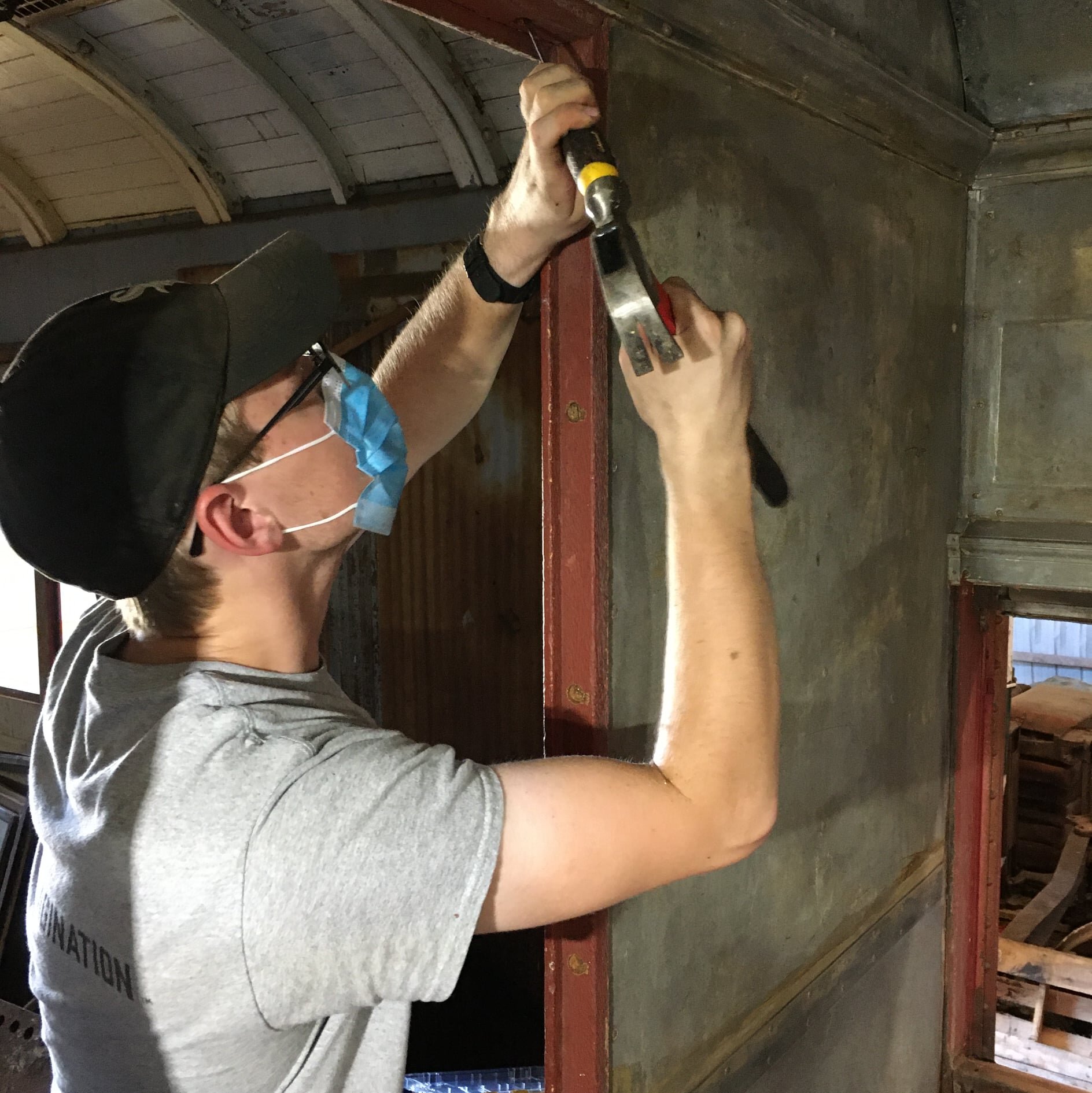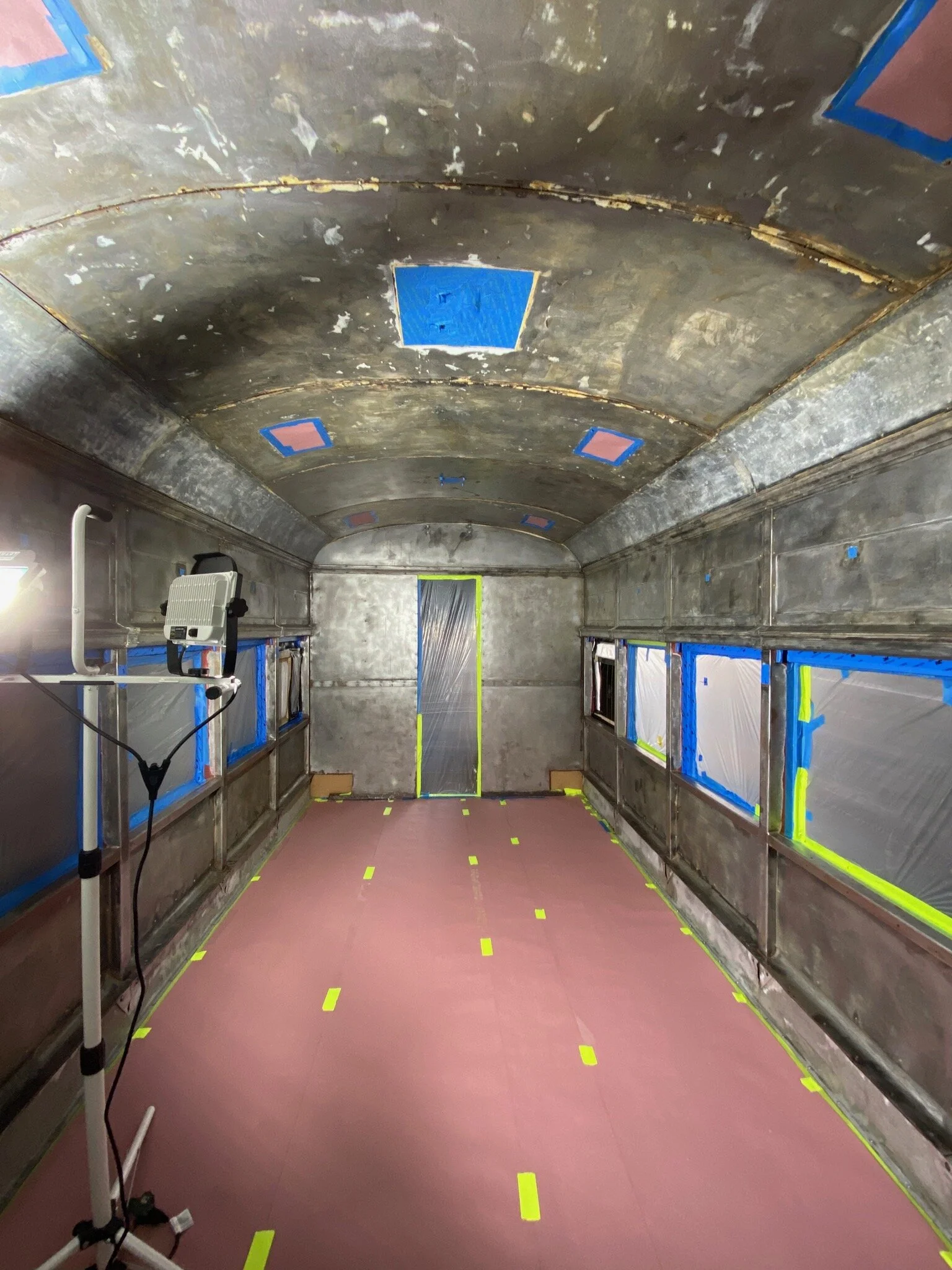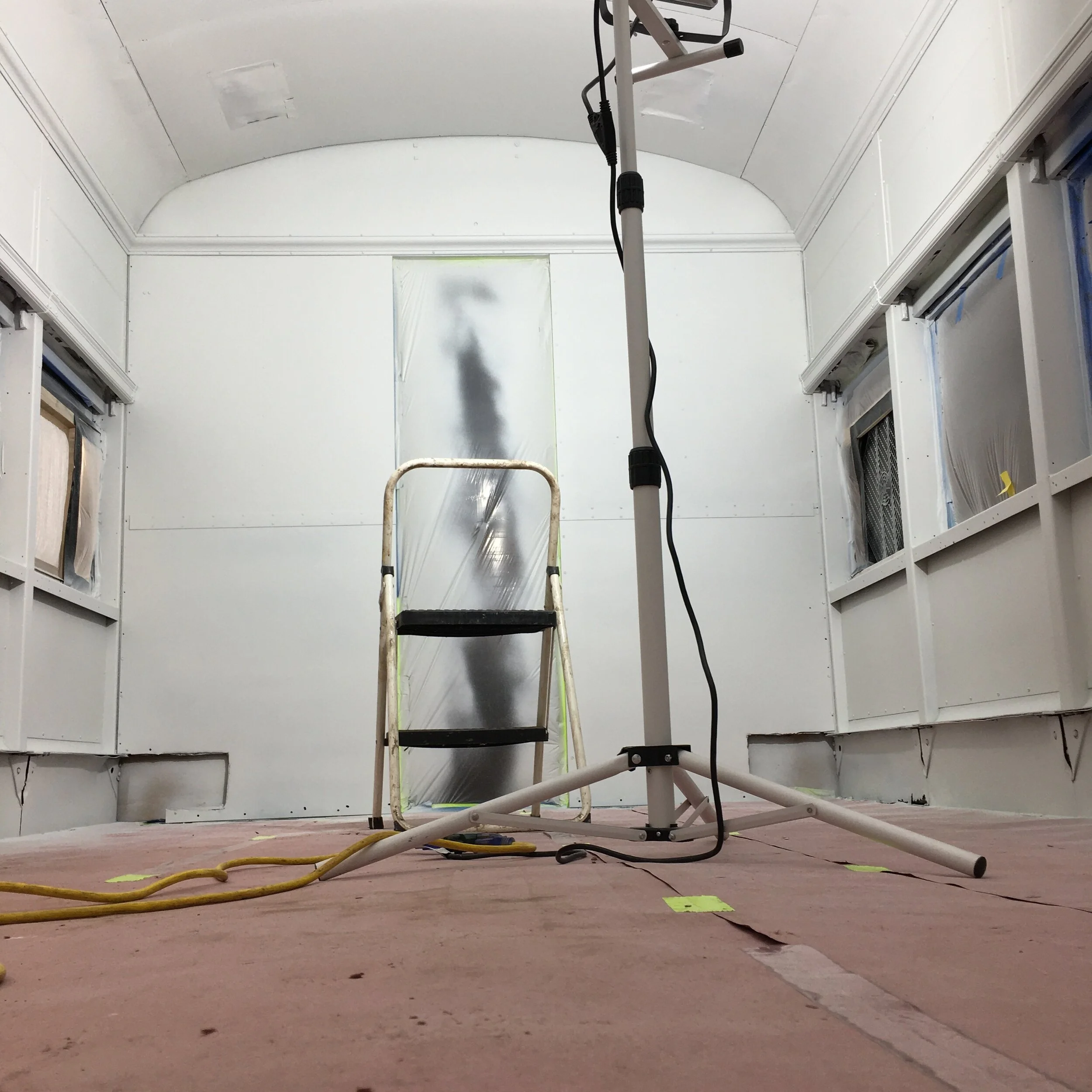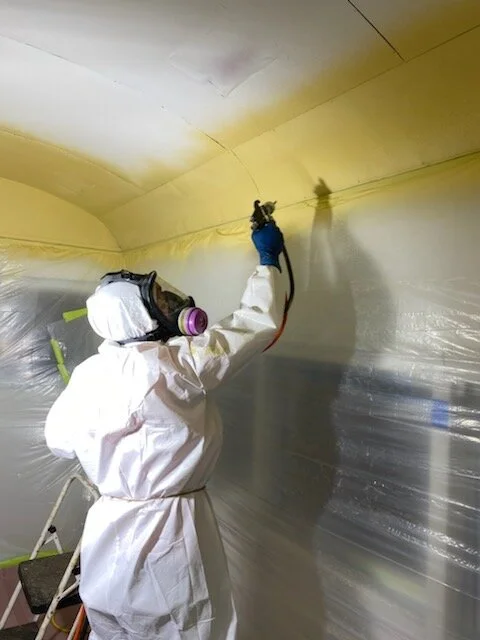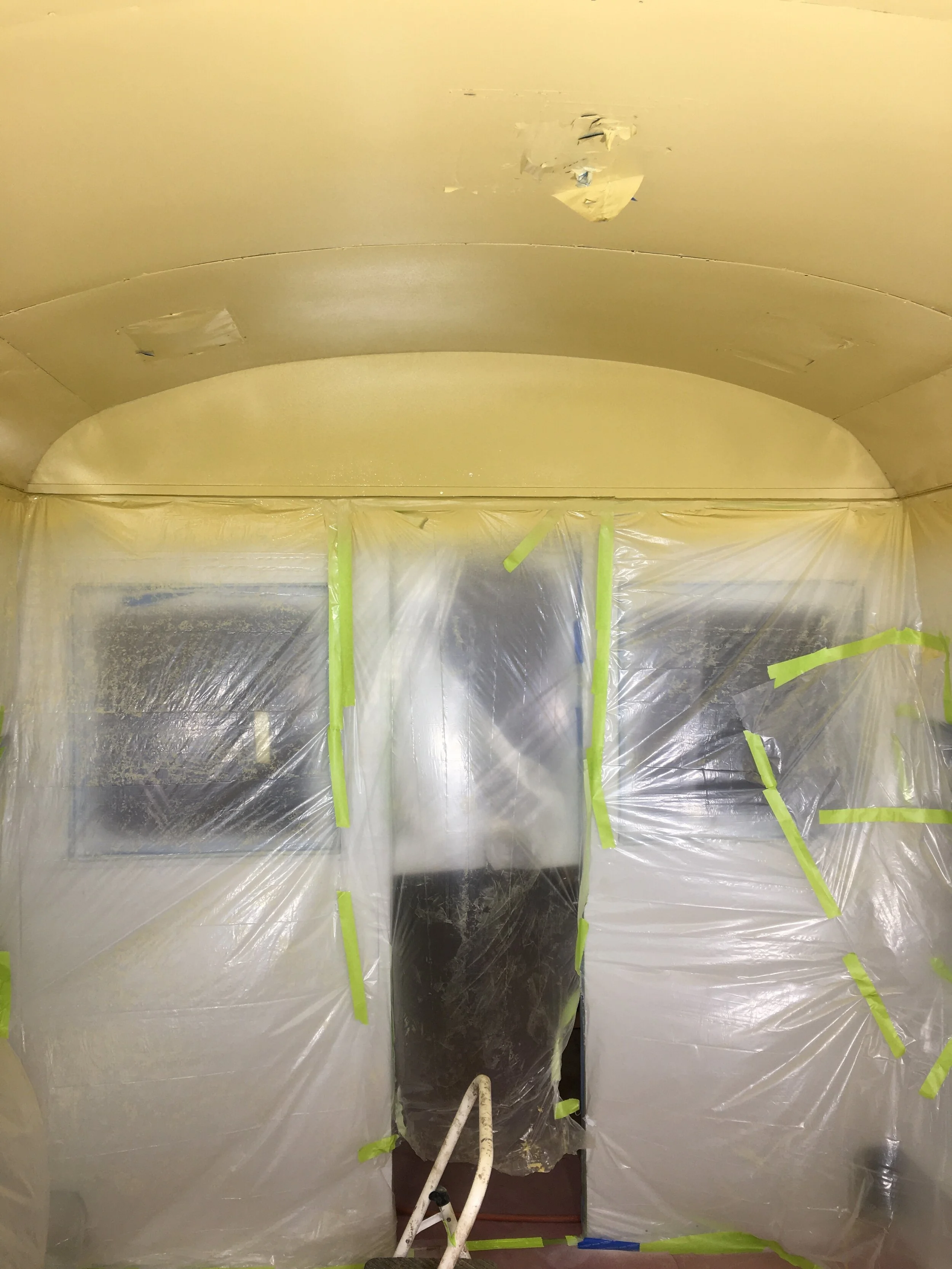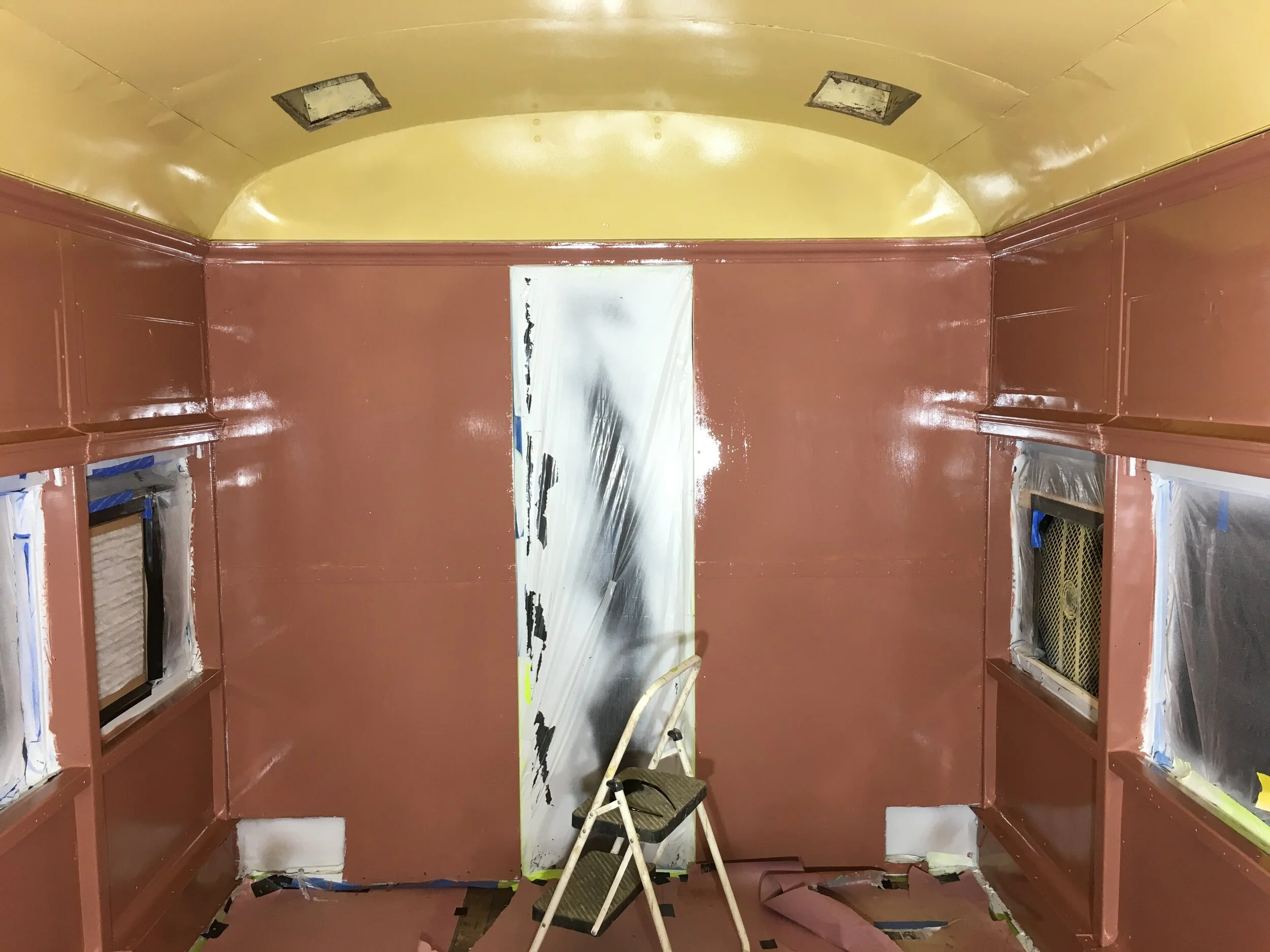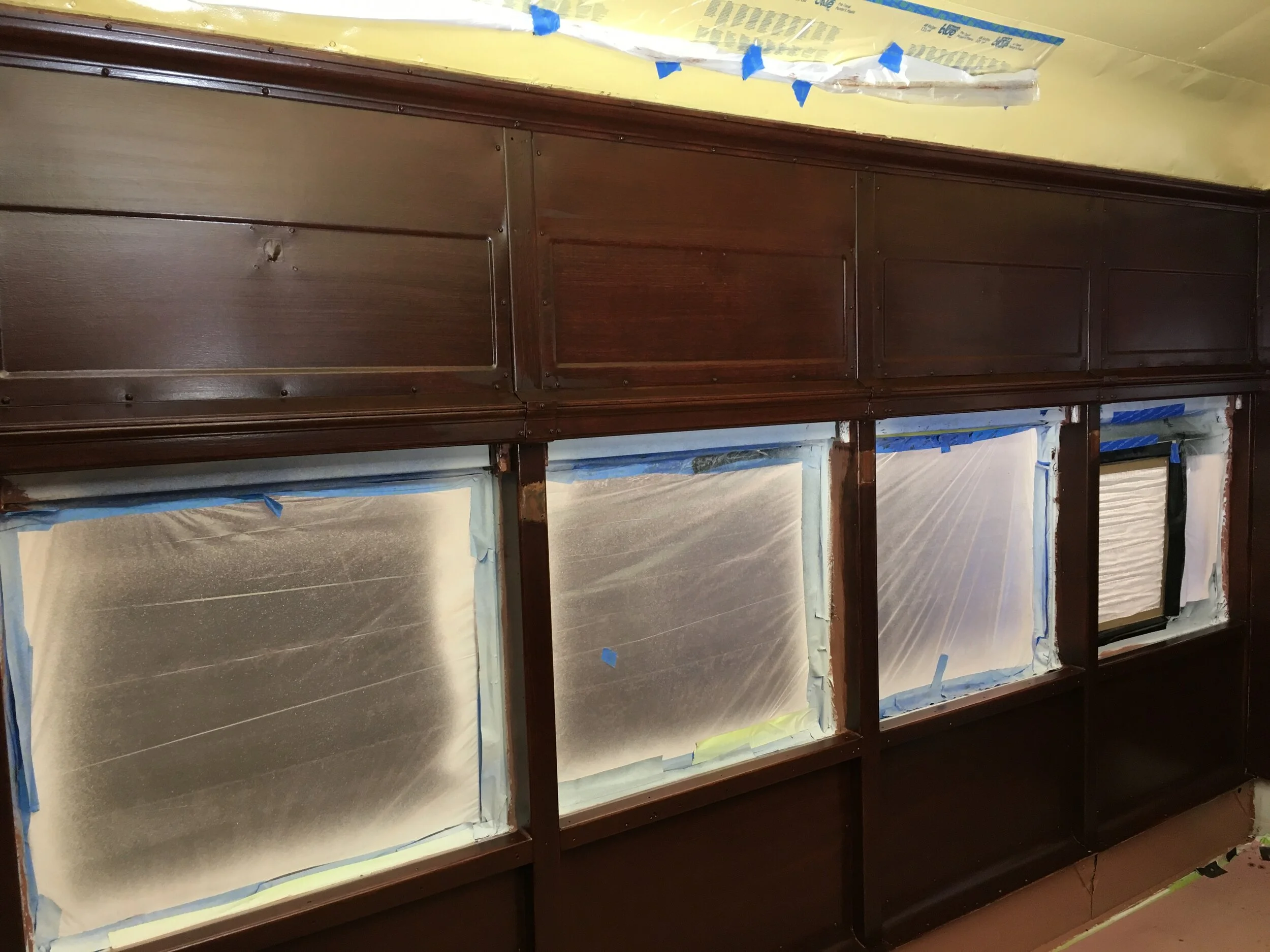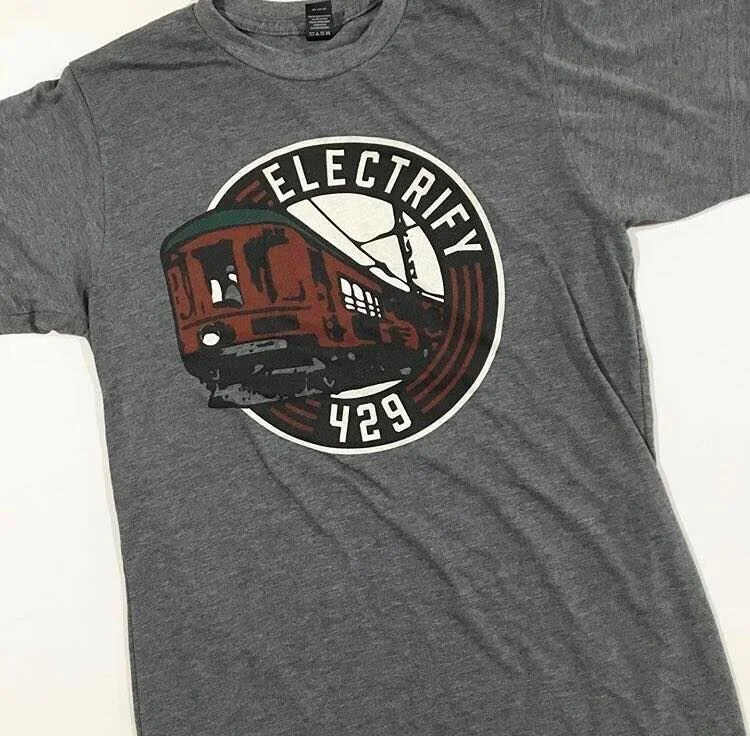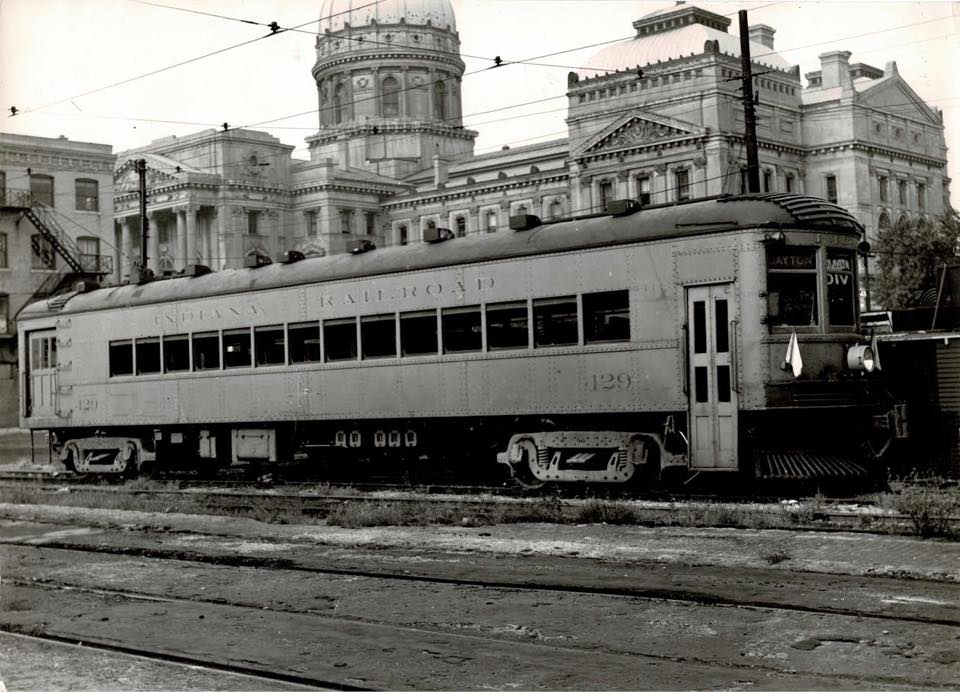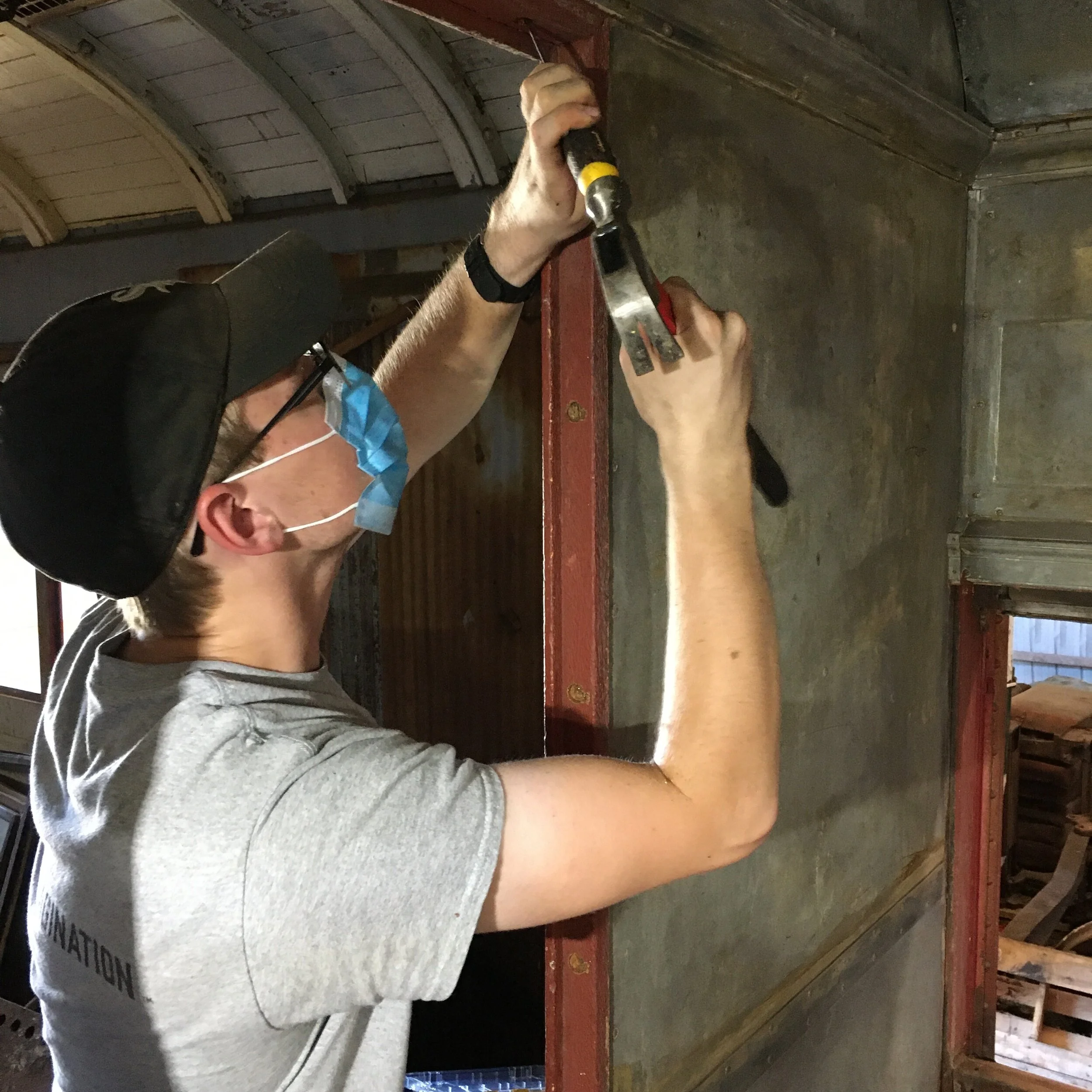Help Revive World-Renowned Hoosier History
We’re sparking imagination by restoring one of Indiana’s last, priceless interurbans to operation for future generations.
Explore this page or select a button below to learn about and engage with Electrify 429.
Go behind the scenes with us as we revive Indiana's interurban legacy for future generations on WFYI Public Media’s Across Indiana!
Why 429?
Moving, empowering and inspiring Hoosiers
It’s 1925
- the world’s changing faster than the speed of light, the American economy is booming, and the State of Indiana is quickly developing industry, culture, and opportunity. You wait patiently at a small station shanty at a crossroads near your farm in rural Alexandria, Ind. - a small farming community between Muncie and Fort Wayne. You meet a younger gentleman named Rufus Thomas, eager for a brighter future, traveling to nearby Anderson, Ind. to attend high school - the first in his family to do so.
A brand new interurban (large, intercity trolley) rolls up to a rapid stop at your crossing - its shiny red paint, gold lettering, and green roof garner attention of the senses. It’s Union Traction Company of Indiana No. 429, named “Noblesville”, fresh from the factory in St. Louis. You climb aboard, greet the conductor, and sit upon a plush, green seat surrounded by faux wood-grain Mahogany walls, brown linoleum, warm lighting, and brass fixtures. The pleasant atmosphere puts you at ease as you cruise at upwards of 80mph towards Indianapolis across streams, rivers, and fields. Your fellow passengers in the nearby smoking section tip their hat towards you as they sip coffee and read the Wall Street Journal, cigar in-hand, lounging upon green, leather seats.
You arrive in Indianapolis and exit at the famous traction terminal (the largest in the world for electric trains), at nine tracks wide and an office nine stories tall. You move about the busy trolley shed across multiple tracks - a terminal that serves 500 trolleys a day and moves more than seven million passengers per year. You exit the terminal onto Illinois Street and enjoy lunch on Monument Circle before a brief business meeting in a nearby office building. You later purchase your fare of one dime and re-board for the trip home, traveling on sister car to No. 429, No. 437 “Marion”, passing the Indiana Statehouse as other cars move around you bound for all corners of the state and beyond.
This is the legacy of Indiana’s electric railway story - our ancestors’ ordinary, yet extraordinary daily lives - people just like you. This is the power of Hoosier fortitude and ingenuity. Together, we’re working to revive our world-renowned electric railway history for future generations by bringing the last remaining interurbans and streetcars back to life along with the stories of their people - culminating in a world class, immersive electric heritage railway. With treasures like No. 429, we’re building a preservation and interpretive tourism asset like none other - telling real stories as well as providing real education, immersion, and transportation.
As America pressed onward, the reign of the automobile and utility/transportation regulation by FDR brought the end of the interurban in 1941. This led to life as a gravel pit office followed by 40 years of dormancy tucked in the back of an Indiana museum for No. 429 - but, today, that changes. We dawn upon a new era as we embark on the journey to bring Union Traction No. 429 back to life - ending a slumber of nearly 80 years.
Together, we will tell the stories of our world-renowned electric railway heritage and our ancestors with the passion they deserve, and together, we will spark imagination.
Together, we will #Electrify429
So, what's the difference between and interurban and a streetcar? What are they?
An interurban, like No. 429, was designed with comfort in mind for high-speed, long-distance travel between cities as well as the occasional movement of perishable goods, like flowers or milk, from farm-to-city.
A streetcar was designed to move people short distances intra-city from one point to another at lower speeds. One would typically take the streetcar to go shopping, go to work downtown, or visit a friend across town.
About the Hoosier Heartland Trolley Company
Hoosier Heartland Trolley Co. was founded in 2018 as an Indiana nonprofit corporation to save the last remaining pieces of Indiana’s electric railway heritage. The organization exists to spark imagination in people across all walks of life through experiencing the art, science, culture, technology and economic empowerment of Indiana’s world-renowned electric railway industry from the 20th century. Read the full incorporation press release.
Our Mission
Hoosier Heartland Trolley Co. exists to spark imagination in people of all ages by bringing all walks of life together to experience the art, science, culture, technology and economic empowerment of Indiana’s world-renowned electric railway industry from the 20th century.
OUR VISION
Hoosier Heartland Trolley Co. is energizing small town America by developing an electric heritage railroad to tell the story of Indiana’s development through the lens of the everyday Hoosiers who made it a reality. This will be an immersive experience set within the context of an existing, everyday Indiana town as a community-based, historic asset - creating opportunity as the electric railways themselves once did.
project scope, timeline, and required capital
scope
overview - Updated February 2022
Electrify 429 is expected to take a regular team of at least 10 personnel nearly five years to complete at a cost of approximately $215,000. Accomplishing this goal would place No. 429 in operational condition for its 100th birthday in 2025. Currently, No. 429 is stored at a private, sheltered site with other Hoosier Heartland Trolley Co. trolleys on a long-term lease through the generosity of two supporting families. No. 429 and the rest of the collection will be relocated to a permanent site in Central Indiana once secured, which is nearing finalization.
HHTC expects to relocate No. 429 near or upon completion to HHTC’s permanent home. While a modest number of hours will be volunteer-based, volunteers with trade skills have been recruited to provide pro bono labor. As outlined, professional services will be contracted out for highly-skilled projects, such as motor rebuilds.
Expertise
The following timeline and outline have been compiled through the consultation of various industry experts and outside parties. HHTC’s leadership team also possesses nearly 90 years of combined experience in the railway preservation field in addition to professional experience in marketing, education, emerging technology, new venture startup, and industrial equipment.
fundraising channels
Electrify 429’s fundraising plans call for an anticipated mix of public crowdsource funding, grants (including matching), and corporate donations / sponsorships. HHTC will engage the public through a number of incentives, programs, and updates throughout the course of the project.
Project timeline and projected capital requirements
The project will consist of four phases, which include:
The interior of No. 429 on the Indiana Railroad. The interior featured a rich, mahogany wood grain finish with checkered-green plush seats and warm lighting. Phase 1 will cosmetically restore the smoking section, which is pictured at the far end of this photo. Krambles-Peterson Archive Photo
PHASE 1: Smoking Section (Summer 2020 - Summer 2022]
Estimated Capital Requirement: $5,000
Scope: Phase 1 will consist of a cosmetic restoration of the smoking section within No. 429. This 10-seat compartment was utilized for smoking passengers. This phase will demonstrate the capabilities of the team, as well as, the cultural, artistic, and industrial significance of the artifact.
Phase 1 will include:
● Repaired ceiling panels
● Refinished
● New electrical wiring
● Restored, original light fixtures
● Reconditioned brass hardware
● Sanding, priming, painting
● Finishing of metal walls with faux mahogany wood-grain finish
PHASE 2: Mechanical & Electrical [Fall 2020 - Fall 2023]
Estimated Capital Requirement: $75,000
Scope: Phase 2 will be the most time and capital-intensive phase of the project. Hoosier Heartland Trolley Co. is consulting with several industry veterans, fellow electric railway operations across the United States, and professional vendors to complete this work. Being of niche expertise, several industrial electrical components will require the assistance of outside contractors and experts, which will contribute to much of the cost.
Amongst the many projects of Phase II, completion of an air brake system, re-profiled wheels, truck rebuilds, and all-new DLC 2KV grade wire will allow No. 429 to function reliably as an immersive artifact for decades to come.
Phase 2 will include:
● Reconditioned traction motors (2)
● Rebuilt industrial electrical components (switches, control stand) Completed 6/30/21
● All-new industrial grade wiring
● Rebuilt and re-plumbed air brake system (compressor, valves, plumbing, tanks, cylinder,
and gauges)
● Re-built trucks (metal housings that hold suspension, bearings, and wheels)
● Custom fabricated brake rigging
● Bearing renewal
● Safety appliances
● Installation of electrical conduit
PHASE 3: Cosmetic [Summer 2024 - Fall 2026]
Estimated Capital Requirement: $80,000
Scope: Phase 3 will be the most visually progressive phase of the project, and such cosmetic phases are commonly referred to as “the icing on the cake”, or when the project visually culminates into the final product. Utilizing museum standards in accordance with the Hoosier Heartland Trolley Co. Collections Policy, which calls for authentic material sourcing and methods, care will be taken to return Union Traction No. 429 “Noblesville” to its as-delivered 1925 appearance from the St. Louis Car Company.
Phase 3 will include:
● Window replacement (safety glass)
● Seat repair, adjustment, and upholstery ($1,000 ea. x 27 units)
● Sanding, painting, and lettering (Union Traction Red with gold lettering, complemented
by a green, canvas roof)
● Repair to baggage racks
● Restoration of original glass light fixtures
● Fabrication of loading steps, grab irons, and ladders
● Installation of brown linoleum flooring
● Manufacturing and installation of window shades / select sash
● Placement of period advertisements
● Replacement of mahogany batten strips
● Repair of baggage doors
● Repair of ceiling panels
PHASE 4: Structural & Roof [Spring 2024 - Fall 2026]
Estimated Capital Requirement: $30,000
Scope: Phase 4 will be a short-lived, but critical phase in comparison to the entire project scope. While No. 429 will be worked on and stored indoors, a secure canvas roof will be vital. While most of the poplar wood strips that make up the roof material are in solid condition, a few will need to be replaced prior to the preparation and installation of a new roof covering consisting of canvas, green paint, and linseed oil. Several vents also make up the roof system on trolley cars, which will be repaired and installed on No. 429. Additionally, medium-duty sheet metal repair consisting of welding and riveting around the bottom sill of a baggage compartment door will be required.
Phase 4 will include:
● Light roof structural repair
● Repair and installation of roof ventilators
● Preparation and installation of roof canvas
● Manufacturing and installation of rain guards
● Medium-duty sheet steel repair around one of the baggage doors
Capital Contingency: $25,000
*Due to the unpredictable nature of restoration projects in railway preservation, market fluctuations, and the possibility for undiscovered obstacles, the team has factored a $25,000 contingency factor into the capital budget.
Total expected capital requirement: $215,000*
Ways to support electrify 429
Financial Giving
You can spark the difference
Every dollar counts towards electrifying No. 429, so that we can spark imagination within generations regarding our world-renowned electric railway heritage for decades to come. Support Electrify 429 at any giving level with a general donation of your desire, or take your support to the next level and become an Electrify 429 Legacy Donor.
Sponsor a major component of the Electrify 429 project or donate more than $100, and become an Electrify 429 Legacy Donor - honored with a place on the permanent Electrify 429 plaque as well as other perks.
Keep track of Electrify 429 component sponsorship progress here.
Select Electrify 429 Interurban Restoration Fund
General donation
Whether $5 or $42.90, every penny indicates your commitment to not only reviving our culturally-defining electric railway heritage, but your support of education, preservation, community place-making, and carrying the Hoosier story forward. Immersion and discovery are the true gateway to Sparking Imagination, and your donation will help make that a reality for future generations - our future. Donate today.
Giving small, monthly donations to Electrify 429 is a great way to sustain restoration progress. Consider monthly giving when filling out the donation form.
Donor Incentives:
Donations above $50 ,and inclusive of, the Electrify 429 Legacy Donor level will receive an Electrify 429 logo sticker. Use your sticker to show your pride for our world-renowned electric railway heritage on your laptop or water bottle.*
The market value of an Electrify 429 sticker is $5 and may affect the deductibility of your donation. As always, please consult with your tax professional if itemizing a deduction.
Soldiers ride from Fort Benjamin Harrison on No. 429 to Indianapolis during the 1930s on the Indiana Railroad. Krambles-Peterson Archive Photo
Electrify 429 Legacy Donor
Use the donation form above to become a Legacy Donor.
Let your mark on the Electrify 429 project be known by future generations. As an Electrify 429 Legacy Donor, any contribution $100 or above will entitle your or an honoree’s name to be inscribed upon the official Electrify 429 plaque that will be placed inside the car, once completed and dedicated. Once developed, the plaque will become a fixture of our permanent home.
Electrify 429 Legacy Donors will also be welcomed to Hoosier Heartland Trolley Company events and initial public offerings prior to the general public. We seek to build and foster long-term relationships in order to further the causes of historic preservation, railway heritage, education, and community development by reviving a snapshot of our world-renowned electric railway history.
Donor Incentives:*
Donations $100 and above will receive a limited edition, tri-blend Electrify 429 logo t-shirt and logo sticker.
*The value of Electrify 429 donor incentives for donations $100 and above are significant in value and may affect the deductibility of your donation, per IRS guidelines. If itemizing a deduction, consult with your tax professional.
Unique 429 Legacy Donor Sponsorship Opportunities:
Sponsorship of specific No. 429 components listed below entitle you or your honoree to a higher level of recognition in return for your generous support. This will consist of all previously listed donor incentives, as well as, a specialized placement upon the official Electrify 429 plaque. Unique, memorable sponsorships available for individual donors include:
Light - $600
Seat - $1,000
Window - $500
Wheel-set - $10,000 - Get in Touch
Traction Motor (Propels the car) - $40,000 - Get in Touch
Are you an owner or member of leadership for a community-engaged business? Explore corporate sponsorship/partnership opportunities.
Volunteer
We are seeking #Electrify429 volunteers from all walks of life whom:
Value teamwork
Treat others with honesty, dignity and respect
Have a passion for being stewards of priceless, historic public treasures such as No. 429
Enjoy building meaningful connections with the public and fellow team members alike
Strive for their best and never settle for less
And have fun at the same time
Bring the stories of Indiana’s world-renowned electric railway history back to life by helping to #Electrify429!
Learn more about our mission, our vision, and our core values. Explore the founding of HHTC and our goals.
Youth volunteers must be at least 16 years of age with parental permission.
Adult volunteers are classified as 18 years of age or older.
Corporate partnerships & sponsorships
Railway preservation touches the core of our legacy and identity as Hoosiers, and upholds social responsibility. By supporting projects like #Electrify429, your brand stands out with action and power through communicating your support for historic preservation, economic development, tourism, education, and furthering our world-renowned electric railway heritage.
The Hoosier Heartland Trolley Company has various tiers of sponsorship available to support our nonprofit mission at the organizational or project level. Options can be customized across our media to align your brand in return for your support. Support could entail a cash contribution, donated materials, or in-kind labor through professional services or a team volunteer day.
See where your organization could align by learning more about our mission, our vision, as well as, our core values and our goals.
History
Indiana Union Traction Company No. 429 - “Noblesville”
-An interurban built in 1925 by the St. Louis Car Company for rapid, electric railway travel to and from Indianapolis - connecting multiple Hoosier towns and cities to the largest electric railway terminal in the world.
No. 429 was built in 1925 by the St. Louis Car Company of St. Louis, MO as part of a 15-car order No. 1344. No. Operated by the Union Traction Company of Indiana from 1925 until 1930, when the Union Traction Company became a part of the Indiana Railroad, the car carried the name “Noblesville” for the town along the line, as did the other cars in the order. Focusing on steel cars to replace aging wooden cars, Union Traction had the cars designed for speed, safety, and long-haul durability. With a height of nearly 13 feet, a length of more than 60 feet, and weighing in at more than 90,000 pounds, cars like No. 429 captured the attention of all the senses.
While part of Union Traction, the car was red with gold lettering and a green, canvas roof. The car operated on the Indiana Railroad from 1930 until 1940, with major rebuilds to one man operation (eliminating the need of a conductor in order to cut costs) occurring between 1935-6 at the former Union Traction Shops in Anderson, Ind. While on the Indiana Railroad, the car was painted orange with green lettering and a green, canvas roof. The car’s interior consisted of a baggage compartment, restroom, smoking section, and general seating section. The seating sections featured faux mahogany walls, green seats, and brown, linoleum floors.
Following retirement, the trolley body was relocated to the Atkinson and Company property located near 60th St. and Fall Creek Parkway in northeast Indianapolis as a gravel pit office. In 1964, the car was moved to the Indiana Transportation Museum in Noblesville, Ind. Days after arriving at ITM, the car had been repainted into Union Traction colors. An effort to rebuild the car into it’s as-built configuration continued in to the 1970s. By 1979, a photograph of the ITM site shows No. 429 outdoors with little, if any work being done to restore the car.
By 2018, the car had been moved indoors, enclosed behind a ‘wall’ of sorts, and largely forgotten for nearly 30 years on a disconnected panel of track. Following closure of the ITM site in Noblesville, HHTC founding members Jakob Stage and Austin Mace purchased the car. The car was acquired along with two additional interurbans and a streetcar, with three other individuals as part of the founding team. The car was then relocated to a privately-owned barn in October of 2018, where initial work to clean, document, and assess the car was performed.
View the original Electric Railway Journal article featuring St. Louis Car Co. Order No. 1344 and No. 429.
Live Wire Blog
Electrify 429 News, Stories & Updates -
Electrify 429 Multimedia
The golden Years



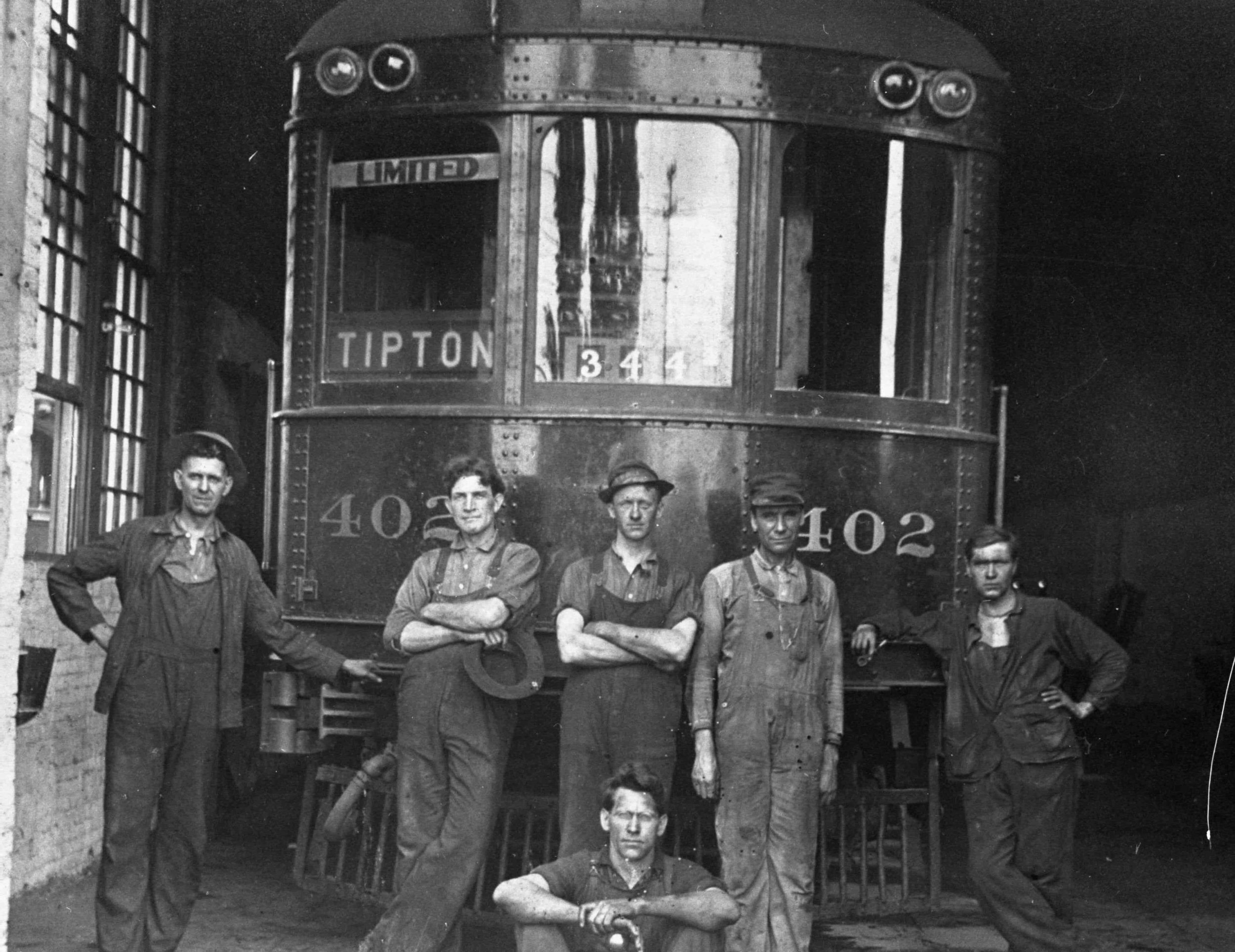


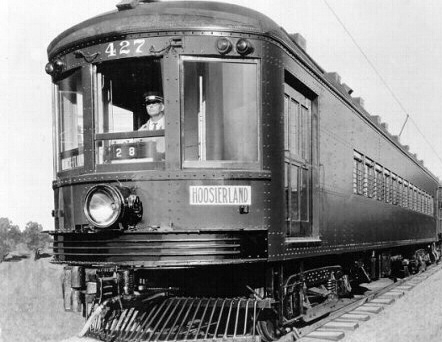

Present day - reviving an icon of hoosier industry







